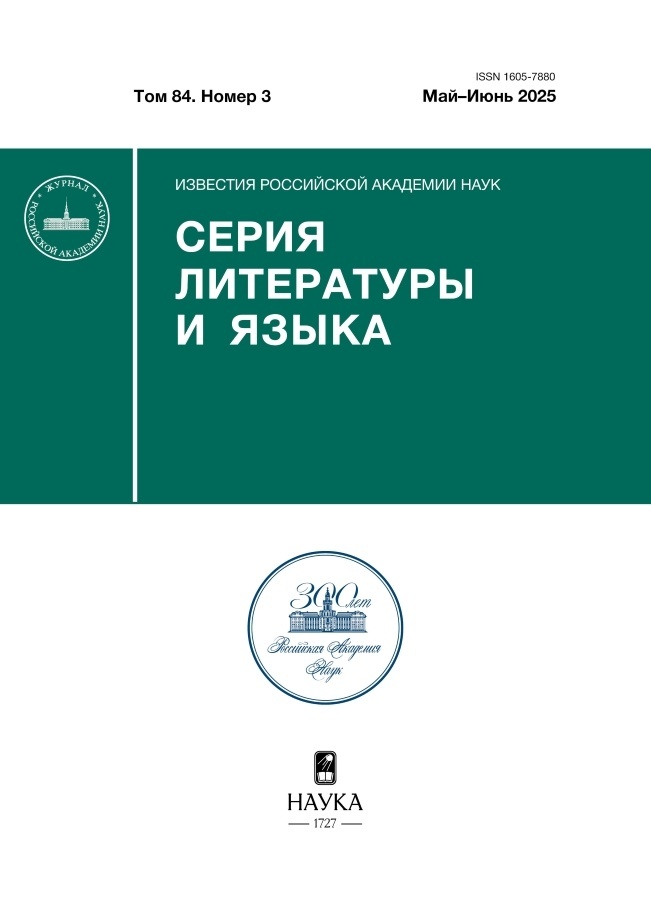Izvestiia Rossiiskoi akademii nauk. Seriia literatury i iazyka
Izvestiya RAN. Seriya literatury i yazyka (The Bulletin of the Russian Academy of Sciences: Studies in Literature and Language), founded in 1852 by Academician Izmail I. Sreznevsky, is the oldest academic journal in Russia for scholars of philology.
Publication history: from 1852 to present.
Founders
- Russian Academy of Sciences
Publisher
- Russian Academy of Sciences
The journal is published under the supervision of the RAS Department of Historical and Philological Sciences (OIFN RAS).
About the journal
As the official journal of the Division of Historical and Philological Studies of the Russian Academy of Sciences (in Russian, ОИФН РАН), Izvestiya RAN. Seriya literatury i yazyka (The Bulletin of the Russian Academy of Sciences: Studies in Literature and Language) is committed to carrying on the Russian philological traditions while seeking to publish innovative research.
The journal offers papers on aspects of literary and linguistic studies, including discussions of fundamental philological works, review articles and chronicles, and transactions of the Division of Historical and Philological Studies of the RAS. One of the journal’s main sections is devoted to resurrection of undeservedly disregarded events from the history of philological scholarship in our country.
Among The Bulletin of the Russian Academy of Sciences: Studies in Literature and Language’s contributors there are Academicians and correspondent members of the Russian Academy of Sciences, researches from academic institutes, many internationally recognized scholars from Moscow, Saint Petersburg, different Russian regions, as well as eminent scholars from other countries.
Editor-in-Chief
- Vadim Polonsky, Corresponding Member of the RAS, Dr. Sci. (Philology), Prof., A.M. Gorky Institute of World Literature of the Russian Academy of Sciences (Moscow, Russia)
Editorial Staff
- Deputy Editor-In-Chief – Leonid Krysin, Dr. Sci. (Philology), Prof., V.V. Vinogradov Russian Language Institute of the Russian Academy of Sciences (Moscow, Russia)
- Executive Editor – Alexander Piperski, Cand. Sci. (Philology), Higher School of Economics (Moscow, Russia)
- Scholarly Editor – Vladimir Korovin, Dr. Sci. (Philology), Assoc. Prof., Lomonosov Moscow State University (Moscow, Russia)
- Editorial Manager – Olga Lukashenko
Subjects
Literature and Language, Linguistics, History of Russian and World Literature, Literary Theory, Folklore Studies, Aspects of History of Art.
Main Headings
- Original Papers
- From the History of Philology
- Reviews
- Chronicles
Frequency
The journal is published bi-monthly (6 issues per year).
Indexing
- RSCI (Russian Science Citation Index) by Clarivate Analytics and eLIBRARY.RU
- ERIH PLUS
- Citation Index by eLIBRARY.RU (Scientific Electronic Library)
- Crossref
The journal is included in the Russian Higher Attestation Commission List of peer-reviewed scientific publications.
Current Issue
Vol 84, No 3 (2025)
Man and His Activities in The Medieval Latin Hymnographic Tradition: The St. Gallen Poetic School as a Case Study
Abstract
The article deals with reflecting the place of man and his activities in the artistic worldview of the medieval hymnographer. Church poetry created in the monastery of St. Gallen in the 9th–10th centuries served as a material for the research. The study showed that the corpus of poetic texts dedicated to the heroes and anti-heroes of Christianity, which developed in St. Gallen, reflected not only general Christian ideas concerning man and his activities, but also the views developed by three like-minded people and friends, the poets Notker Balbulus, Ratpert and Tuotilo. Poetic texts, combined with music and performed during services not only in St. Gallen, but also in other monasteries and churches in Europe, made it possible to disseminate these views in a form convenient for assimilation and memorization. The school of St. Gallen, where the poets taught, was known throughout Europe and had a reputation as a place where they not only provided an excellent education, but also paid attention to the spiritual development of their students. Boys from aristocratic families entered the school, and later became abbots of monasteries, missionaries, and bishops. They did not lose contact with the monastery and, occupying high church positions, became conduits not only of the Christian, but also of the St. Gallen worldview, in which an important place was occupied by man whose actions determined his life and posthumous destiny.
 5-14
5-14


From the Novel “Y” to the Novel “Crimson Sunset”: Vs. Ivanovʼs Work on Studying Factories in the 1930s
Abstract
 15-25
15-25


Concerning the Functions of Fully Stressed Rhythmic Form (Based on the Poetry of Joseph Brodsky)
Abstract
 26-36
26-36


Polymetrical Verse by Genrikh Sapgir (On the Example of Cycle of Poems “Memories with Angels in Kraskovo”)
Abstract
 37-48
37-48


Neo-Victorian Fairy-Tale Topos and the Ways of its Creation” in “The Children’s Book” by A. S. Byatt
Abstract
 49-61
49-61


The Meaning and Realization of the Wandering Rocks Mythologeme in the Context of the Tenth Episode of “Ulysses” by James Joyce
Abstract
 62-76
62-76


Ways of Translating Polish Predicative Past Passive Participles into Old Church Slavonic in “Ecclesiastical Annals” of the 17th Century
Abstract
 77-87
77-87


Yuly Aykhenvald and Collected Works of A. S. Pushkin Published by Vengerov (Based on Materials from the Manuscripts Department of the Institute of Russian Literature)
Abstract
 88-101
88-101


Reviews
Chernozemova, E. N. Conversation about Dignity and Honour in the System of Genres of English Drama of the Late 16th Century. Moscow: De’Libri Publ., 2024. 276 p. [In Russ.]
 102-104
102-104


Estate and Dacha – Moving on. Review of the Book: Bogdanova, O. A. Hermeneutics of the Literary Estate: Theory, History, Modernity: Monograph. Ed. by M. V. Skorokhodov. Moscow: IWL RAS Publ., 2024. 560 p. (Series “Russian Estate in the Global Context”. Issue 9). [In Russ.]
 105-108
105-108


Chronicles
Main Linguistic Events: The 21st International Congress of Linguists (21 ICL: Languages – Communities – Technologies (Poznań, September 8–14, 2024) and the First Eurasian Congress of Linguists (Moscow, December 9–13, 2024)
 109-118
109-118


The 26th International Conference “Speech and Computer” SPECOM-2024
 119-126
119-126










